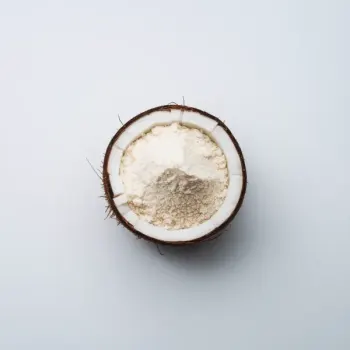Coconut flour and almond flour are gluten-free, low-carb baking alternatives with distinct tastes and textures, suitable for different recipes and dietary needs. Coconut flour is highly absorbent and fiber-rich, while almond flour is denser, moist, and high in healthy fats.

Coconut flour is a soft flour produced from dried coconut meat. It's a byproduct of coconut milk production and is popular for its high fiber content, low carbohydrate count, and gluten-free nature.

Almond flour, also known as almond meal, is made from ground almonds. It's favored for its rich flavor, healthy fats, and versatility in baking and cooking. It's also gluten-free and low in carbs, making it a staple in many dietary plans.
Coconut flour has a mild, sweet coconut flavor and a soft, airy texture that can be quite absorbent in recipes. It's derived from coconut meat, making it suitable for those with nut allergies. Almond flour, on the other hand, has a nutty taste and a denser texture that provides a moist and rich quality to dishes. It is made from ground almonds, which means it's not suitable for individuals with nut allergies.

Your ultimate Recipe Box, Meal Planner, and Cooking Class all in one
Best used in recipes like coconut flour pancakes, muffins, and quick breads. Coconut flour's absorbency requires an increased amount of liquid and eggs for binding, offering a light and fluffy texture. When using coconut flour, expect a drier baked good that may need additional moisture from other ingredients. Ideal for items like almond flour cookies, cakes, and breads. It provides a moist, rich crumb and binds well with other ingredients. Use almond flour for a denser and slightly chewy texture with a buttery flavor. It's excellent for French macarons and other delicate pastries.
It can be used as a thickener in soups and sauces or as a coating for proteins like chicken or fish. Expect a slight coconut flavor and a lighter consistency in the final dish. Almond flour works well as a breadcrumb alternative for meatballs, meatloaf, and as a crust for quiche. It adds a nutty taste and a hearty texture that complements savory flavors.
Use it to create gluten-free versions of bread, pizza crusts, and cakes. It's a great option for those seeking a low-carb alternative, but remember to increase the number of eggs for structure and moisture. Almond flour is excellent for gluten-free pie crusts, scones, and pancakes. It provides a tender texture and a rich flavor, making gluten-free recipes taste more indulgent.
Both coconut flour and almond flour offer health benefits and are suitable for gluten-free diets.
| Nutrient | Almond Flour ( per 1/4 Cup ) | Coconut Flour ( per 1/4 Cup ) |
|---|---|---|
| Fat | 14g | 3g |
| Fiber | 3g | 10g |
| Sodium | 0mg | 15mg |
| Protein | 6g | 4g |
| Calories | 160 | 120 |
| Carbohydrates | 6g | 18g |
No, due to differences in absorbency and fat content, they are not directly interchangeable. Adjustments to the recipe are necessary when substituting.
Each has its own health benefits. Coconut flour is lower in calories and higher in fiber, while almond flour is higher in protein and healthy fats.
Yes, coconut flour is not a nut and is generally considered safe for those with nut allergies.
You will need to increase the number of eggs and potentially other liquid ingredients due to coconut flour's high absorbency.
Yes, almond flour is low in carbohydrates and high in healthy fats, making it suitable for a ketogenic diet.